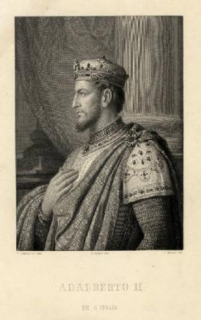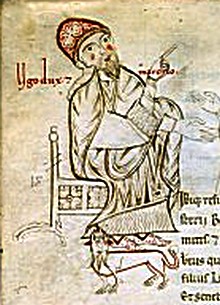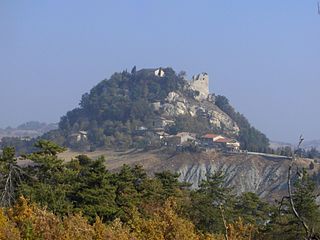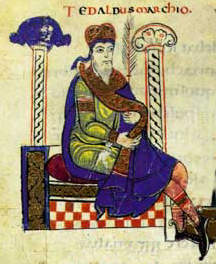Tedald (died 1012), of the House of Canossa, was the count of Brescia from 980, Modena, Ferrara, and Reggio from 981, and Mantua from 1006. He used the title of margrave because of his vast comital holdings and their frontier nature. His family's seat was Canossa and he was the son of Adalbert Azzo of Canossa who had supported Otto I against Berengar of Ivrea and Adalbert of Ivrea. His rise was largely due to his loyalty to the Ottonian Dynasty.

The House of Canossa, also known as the Attonids, was an Italian noble family, holding the castle of Canossa, from the early tenth to the early twelfth century.

Brescia is a city and comune in the region of Lombardy in northern Italy. It is situated at the foot of the Alps, a few kilometres from the lakes Garda and Iseo. With a population of about 200,000, it is the second largest city in the region and the fourth of northwest Italy. The urban area of Brescia extends beyond the administrative city limits and has a population of 672,822, while over 1.5 million people live in its metropolitan area. The city is the administrative capital of the Province of Brescia, one of the largest in Italy, with over 1,200,000 inhabitants.

Modena is a city and comune (municipality) on the south side of the Po Valley, in the Province of Modena in the Emilia-Romagna region of northern Italy.
He opposed his fellow Margrave Arduin of Ivrea in his bid for the Italian crown in 1002. He accompanied the Emperor Henry II on his campaign to Italy in 1004 and was present at Henry's royal coronation in Pavia on May 15. He received Ferrara from the pope. He ensured that his entire patrimony passed to his son Boniface. His second son, Tedald, became Bishop of Arezzo in 1023 and sponsored Guido of Arezzo.

Arduin was an Italian nobleman who was Margrave of Ivrea and King of Italy (1002–1014).

Pavia is a town and comune of south-western Lombardy, northern Italy, 35 kilometres south of Milan on the lower Ticino river near its confluence with the Po. It has a population of c. 73,000. The city was the capital of the Kingdom of the Lombards from 572 to 774.

The pope, also known as the supreme pontiff, is the Bishop of Rome and ex officio leader of the worldwide Catholic Church. Since 1929, the pope has also been head of state of Vatican City, a city-state enclaved within Rome, Italy. The current pope is Francis, who was elected on 13 March 2013, succeeding Benedict XVI.
Tedald married Willa daughter of Hubert of Spoleto, natural son of Hugh of Italy.
Hugh of Arles was King of Italy from 924 until his death in 947. He was a Bosonid. During his reign, he empowered his relatives at the expense of the aristocracy and tried to establish a relationship with the Byzantine-Roman Empire. He had success in defending the realm from external enemies, but his domestic habits and policies, which showed some evidence of culture in an otherwise barbaric century, created many internal foes and he was removed from power before his death.

Berengar II was the King of Italy from 950 until his deposition in 961. He was a scion of the Anscarid and Unruoching dynasties, and was named after his maternal grandfather, Berengar I. He succeeded his father as Margrave of Ivrea around 923, and after 940 led the aristocratic opposition to Kings Hugh and Lothair II. In 950 he succeeded the latter and had his son, Adalbert crowned as his co-ruler. In 952 he recognised the suzerainty of Otto I of Germany, but he later joined a revolt against him. In 960 he invaded the Papal States, and the next year his kingdom was conquered by Otto. Berengar remained at large until his surrender in 964. He died imprisoned in Germany two years later.

Boniface III, son of Tedald of Canossa and the father of Matilda of Canossa, was the most powerful north Italian prince of his age. By inheritance he was Count of Brescia, Canossa, Ferrara, Florence, Lucca, Mantua, Modena, Pisa, Pistoia, Parma, Reggio, and Verona from 1007 and, by appointment, Margrave of Tuscany from 1027 until his assassination in 1052.

Adalbert was the King of Italy from 950 until 961, ruling jointly with his father, Berengar II. After his deposition, he continued to claim the Italian kingdom until his defeat in battle in 965. Since he was the second Adalbert in his family, the Anscarids, he is sometimes numbered Adalbert II. It is occasionally, especially in older works, shortened to Albert, which has the same roots.
Boso was a Burgundian nobleman who spent much of his career in Italy, where he became Margrave of Tuscany about 932. He ruled semi-autonomously and was a benefactor of the churches of his region. He lost his office in 936 and probably returned to Burgundy.
Hubert was the illegitimate son of King Hugh of Italy and his concubine Wandelmoda. He became Margrave of Tuscany in 936 and Duke of Spoleto and Margrave of Camerino in 943.

Hugh, called the Great, was the Margrave of Tuscany from 969 until his death, and the Duke of Spoleto and Margrave of Camerino from 989 to 996. He restored the state apparatus in Tuscany after decades of neglect by margraves whose main interests lay elsewhere. Hugh supported the new Ottonian dynasty, and was praised for his justice by the contemporary theologian Peter Damian in his De principis officio.
The March of Ivrea was a large frontier county in the northwest of the medieval Italian kingdom from the late 9th to the early 11th century. Its capital was Ivrea in present-day Piedmont, and it was held by a Burgundian family of margraves called the Anscarids. The march was the primary frontier between Italy and France and served as a defense against any interference from that state.
Adalbert I was the margrave of Ivrea, the second of the Anscarid dynasty, from the late 890s until his death. In the intermittent civil war which affected Italy from 888 into the 930s, Adalbert initially strove to remain neutral, but from 901 on he sided sequentially with every claimant to the Italian throne.

Canossa is a comune and castle town in the Province of Reggio Emilia, Emilia-Romagna, northern Italy. It is the site where Holy Roman Emperor Henry IV did penance in 1077, standing three days bare-headed in the snow, in order to reverse his excommunication by Pope Gregory VII. The Walk to Canossa is sometimes used as a symbol of the changing relationship between the medieval Church and State.

Adalbert Atto was the first Count of Canossa and founder of that noble house which eventually was to play a determinant role in the political settling of Italy and the Investiture Controversy in the eleventh and twelfth centuries.
Ulric Manfred II or Manfred Ulric was the count of Turin and marquis of Susa in the early 11th century. He was the last male margrave from the Arduinid dynasty. Ulric Manfred's daughter, Adelaide, inherited the majority of his property. Through marriage to Adelaide (c.1045), Otto of Savoy, a younger son of Count Humbert I of Savoy became margrave of Turin. Their descendants would later comprise the House of Savoy who ruled Sardinia and Italy.
Arduin Glaber was count of Auriate from c. 935, count of Turin from c. 941/2, and Margrave of Turin from c. 950/64. He placed his dynasty, the Arduinici, on a firm foundation and established the march of Turin through conquests and royal concessions. The Chronicon Novaliciense, the chronicle of the abbey of Novalesa, is the primary source for his life.
Conrad Cono(n) was the Margrave of Ivrea from 970 to his death and Duke of Spoleto and Camerino (996-1001). He was the third son of Berengar II of Italy and Willa of Tuscany. His elder brothers were Adalbert and Guy, both of whom ruled the march before him. His father made him, possibly, the first Count of Ventimiglia.
Albert Atto I was an Italian nobleman. He was a member of the Obertenghi family. From 1014 onward, he was margrave of Milan and count of Luni, Genoa and Tortona.
Tedald, Tedaldo, or Tedaldus may refer to:
Theobald II was the Duke of Spoleto and Margrave of Camerino from 953. He was the son of Boniface II of Spoleto and Waldrada. He married a woman also named Waldrada and was the father of Adalbert, Count of Bologna, and possibly of Willa, the wife of Tedald of Canossa.
Otbert was Margrave of Milan. A member of the Obertenghi family, he succeeded his father, Otbert I, as margrave after his father's death in 975, together with his brother Adalbert. He was also count of Milan, Genoa, and Bobbio. In 1002, he joined Arduin's revolt against Henry II, Holy Roman Emperor.
Adela of Milan was a northern Italian noblewoman. Through marriage to Albert Azzo I, Margrave of Milan, Adela was margravine of Milan.












